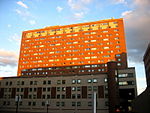Murder of Tessa Majors
The murder of Tessa Majors occurred near Morningside Park in Morningside Heights, Manhattan, on December 11, 2019. Majors, an eighteen-year-old student at Barnard College, was attacked and stabbed by three teenagers as part of a robbery. Majors was discovered collapsed and bleeding on a staircase exiting Morningside Park and transported to a nearby hospital, ultimately succumbing to the injuries. One of the suspects, a thirteen-year-old, was arrested the following day and charged with felony murder. Two months later, two fourteen-year-old suspects, Luchiano Lewis and Rashaun Weaver, were also charged with murder. On June 3, 2020, the 13-year-old (since turned 14) pleaded guilty in family court to robbery in the first degree. On September 21, 2021, Lewis pleaded guilty to second-degree murder and first-degree robbery. In December 2021, Weaver pleaded guilty to second-degree murder, first-degree robbery, and second-degree robbery. The 13-year-old was sentenced to 18 months of detention while Lewis was sentenced to nine years to life in prison, and Weaver was sentenced to 14 years to life in prison.
Excerpt from the Wikipedia article Murder of Tessa Majors (License: CC BY-SA 3.0, Authors).Murder of Tessa Majors
Morningside Drive, New York Manhattan
Geographical coordinates (GPS) Address Nearby Places Show on map
Geographical coordinates (GPS)
| Latitude | Longitude |
|---|---|
| N 40.8057 ° | E -73.9594 ° |
Address
guard house
Morningside Drive
10027 New York, Manhattan
New York, United States
Open on Google Maps





